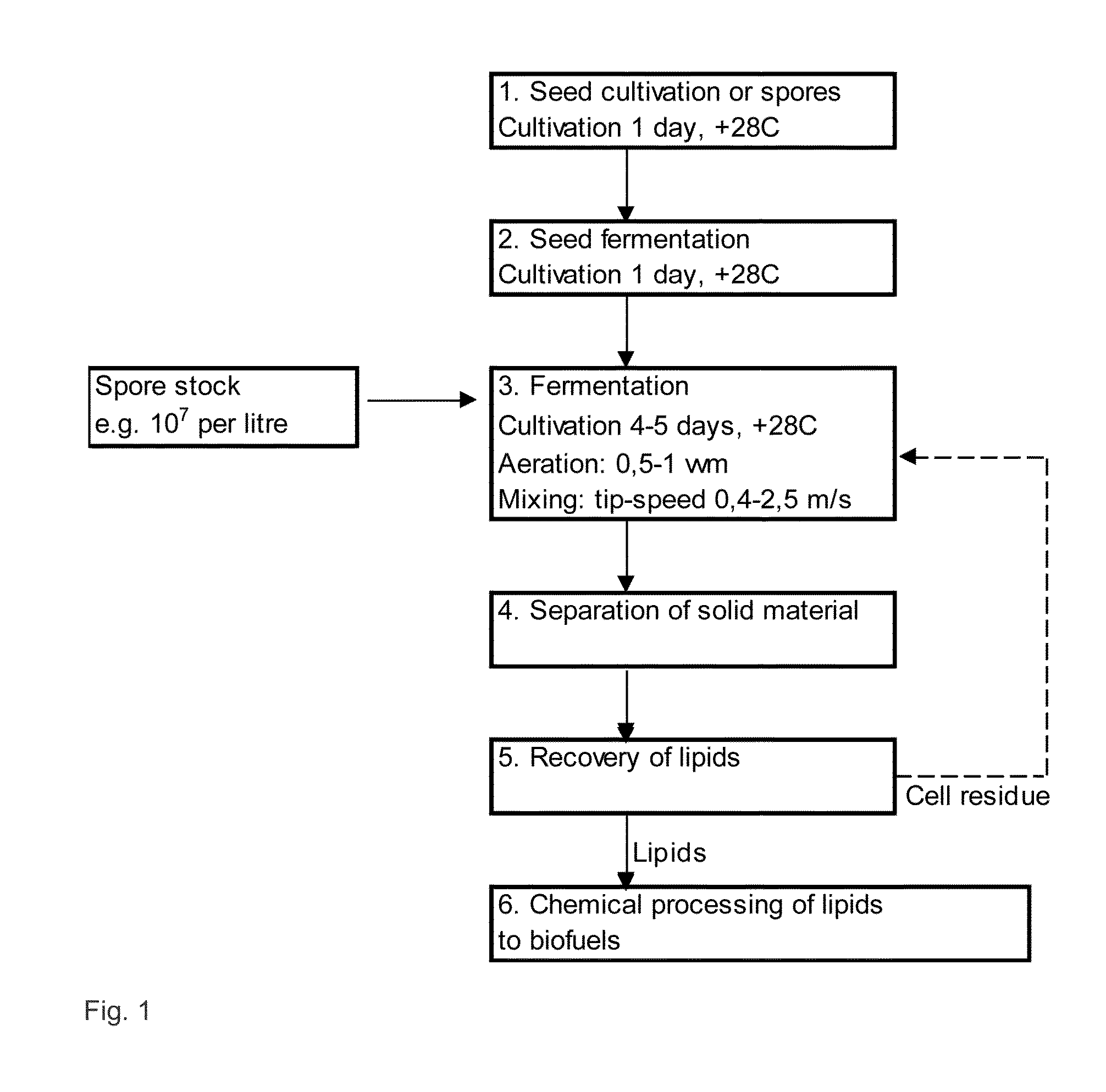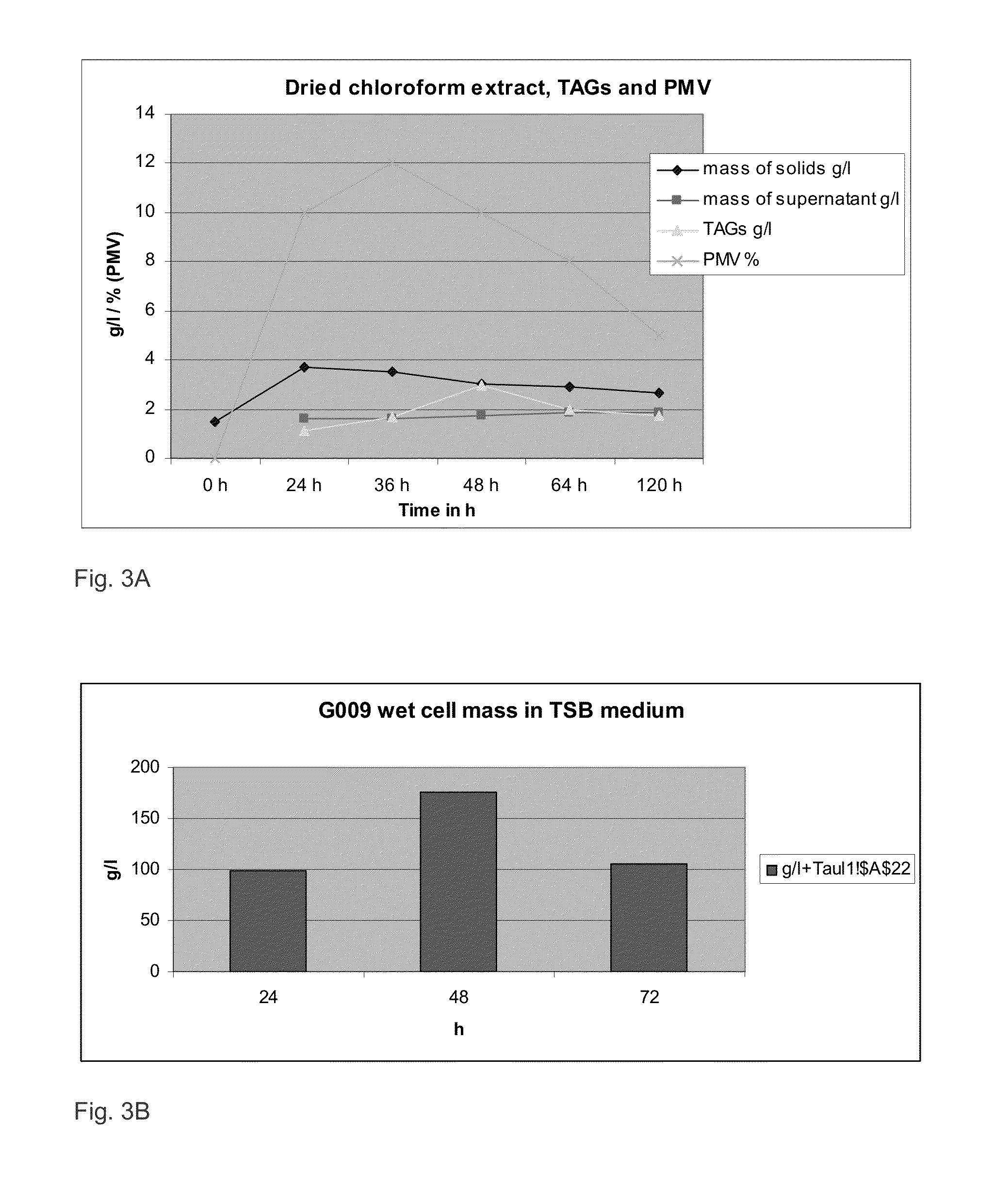Process and microorganisms for production of lipids from lignocellulosic wastes or residues
a technology of lignocellulosic waste and microorganisms, which is applied in the direction of transferases, chemical treatment enzyme inactivation, bacteria-based processes, etc., can solve the problems of increasing ethically short-lived use of edible crops to create fuel instead of further refining them to food for increasing human population, large product volume, and high cost. , to achieve the effect of cost-effectiveness
- Summary
- Abstract
- Description
- Claims
- Application Information
AI Technical Summary
Benefits of technology
Problems solved by technology
Method used
Image
Examples
example 1
Screening of Streptomycetes for Accumulation of Lipids
[0216]Streptomyces species from the local culture collection (Table 1) were tested for growth on standard cultivation conditions to elucidate the cycle time, cell mass and accumulation of lipids. The strains were cultivated in typical broth, in tryptone soy broth TSB (Difco) for two to three days in a shaker (100-330 rpm, 26-34° C.). The following strains were found to give a high cell mass and accumulation of lipids in remarkable quantities in the standard cultivation conditions: GAL4111 (Streptomyces roseosporus), GAL1005 (Streptomyces griseus), GAL1001 (Streptomyces albus) and GAL4082 (Streptomyces peucetius D2).
[0217]An aliquot of the spore suspension or a loop of mycelia of each strain was used to inoculate 50 ml of TSB medium in 250 ml Erlenmeyer flask. Incubation with shaking was allowed to continue for three days and a sample of 10 ml was taken in each day of cultivation, e.g. in 24 hours intervals. The following characte...
example 2
Construction of Genetically Modified Strains
[0219]Two strains, GAL4111 and GAL1001 were used as the hosts of genetic engineering though the same methods are useful for GAL005 and GAL4082 and for several other streptomycetes. In addition, a blocked mutant of daptomycin producing GAL4111 was generated to prevent production of antibiotics in cultivations and designated as G011. Interestingly, all other cultivation properties of G011 were the same as found in GAL4111 except the lack of accumulation of lipopeptide antibiotics in detectable quantities in G011. G011 accumulates TAGs and the other lipids in similar quantities in the same cultivation conditions as GAL4111.
[0220]If referred to the standard methods in construction of genetically modified strains, these are found in the Streptomyces manual by Kieser et al., 2000 for streptomycetes and in Sambrook and Russell, 2001 for E. coli.
Plasmid Constructions:
[0221]The genes that are involved in fatty acid biosynthesis called sco0958 and ...
example 3
Small-Scale Cultivation of GMO-Streptomycetes for Accumulation of Lipids
[0228]The strains G009, G010, G012, G013, G014, G015, G016, G017 and G019 were cultivated in the conditions as described here. The host strains, G011, GAL4111 and GAL1001 were used as controls in cultivations.
Typical Cultivation Conditions:
Temperature: 22-36° C.
pH: 5.0-8.5
agitation: 0-330 rpm
inoculum form: vegetative mycelia, substrate mycelia, spores
transferring rate: 0.5-50 G / 0
medium in use: TSB, E05 as given in Example 1 and different kinds of waste or residue medias as described in example 4.
[0229]The accumulation of TAG was compared to that of the wild type, GAL1001 and GAL4111 by TLC analysis. FIG. 5 demonstrates an example of the accumulation of TAGs in different media by the strains G017, G016, G013 and G011. There was a clear increase in accumulation of lipids and especially TAGs in the GMO strains carrying the gene sco0958 and increase in those clones (strains) carrying sco5888 in different plasmid vec...
PUM
| Property | Measurement | Unit |
|---|---|---|
| concentrations | aaaaa | aaaaa |
| concentrations | aaaaa | aaaaa |
| concentrations | aaaaa | aaaaa |
Abstract
Description
Claims
Application Information
 Login to View More
Login to View More - R&D
- Intellectual Property
- Life Sciences
- Materials
- Tech Scout
- Unparalleled Data Quality
- Higher Quality Content
- 60% Fewer Hallucinations
Browse by: Latest US Patents, China's latest patents, Technical Efficacy Thesaurus, Application Domain, Technology Topic, Popular Technical Reports.
© 2025 PatSnap. All rights reserved.Legal|Privacy policy|Modern Slavery Act Transparency Statement|Sitemap|About US| Contact US: help@patsnap.com



